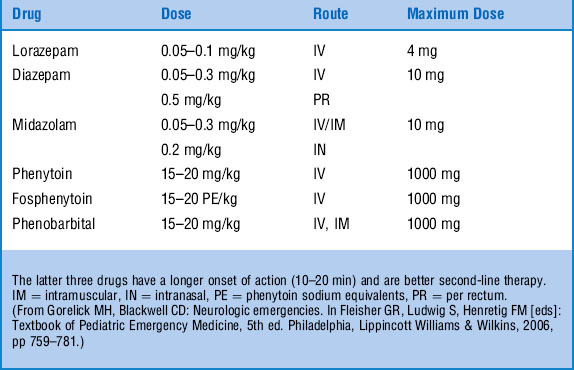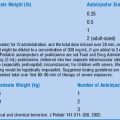Chapter 32 Central Nervous System Emergencies
2 What is the definition of status epilepticus?
Tharp BR: Clinical features and complications of status epilepticus in children, 2006. Available at www.uptodate.com.
4 A child is having an acute seizure. You know that IV access will not be possible quickly. What are your options?
 Intraosseous access (any medication listed in Table 32-1 can be given through an intraosseous line)
Intraosseous access (any medication listed in Table 32-1 can be given through an intraosseous line)
Wiznitzer M: Buccal midazolam for seizures. Lancet 366:182–183, 2005.
7 What are infantile spasms?
Glaze DG: Management and prognosis of infantile spasms, 2006. Available at www.uptodate.com.
8 A 16-year-old boy presents after an early-morning generalized tonic clonic seizure. On history, he describes occasional, brief, jerking movements in the morning that make teeth brushing and hair combing difficult. These jerking movements resolve and do not recur later in the day. What does this symptom pattern suggest?
10 What are the indications for urgent computed tomography (CT) after a seizure?
11 What are the indications for nonurgent MRI after a seizure?
 Cognitive or motor impairment of unknown etiology
Cognitive or motor impairment of unknown etiology
 Changes in seizure character, neurologic examination, or electroencephalogram
Changes in seizure character, neurologic examination, or electroencephalogram
MRI testing for the preceding indications avoids unnecessary radiation exposure from CT.
12 What is the incidence of febrile seizures? When do they occur?
American Academy of Pediatrics. Available at www.aap.org/patiented/febrileseizures.htm.
13 What makes a febrile seizure “simple” or “complex”?
A simple febrile seizure has all of the following characteristics:
A complex febrile seizure has at least one of the following characteristics:
14 What is the recurrence risk for a febrile seizure?
Approximately 30%. This number varies by age at onset of first febrile seizure.
15 Is the risk of recurrence increased if the initial febrile seizure is complex?
No. Children at greater risk of recurrence may have one or more of the following features:
16 Is the risk of epilepsy increased in children with febrile seizures?
Waruiru C, Appleton R: Febrile seizures: An update. Arch Dis Child 89:751–756, 2004.
18 When should you consider a lumbar puncture in a child with a febrile seizure?
19 In a child with suspected meningitis, what are some contraindications to performing an immediate lumbar puncture?
 Focal neurologic findings on examination
Focal neurologic findings on examination
 Evidence of spinal cord trauma
Evidence of spinal cord trauma
 Infection in the tissues near the puncture site
Infection in the tissues near the puncture site
In these cases, antibiotic therapy may be initiated presumptively and lumbar puncture delayed.
22 What are some differentiating features of Guillain-Barré syndrome and transverse myelopathy?
| Symptom | Guillain-BarréSyndrome | TranverseMyelopathy |
|---|---|---|
| Early pain/paresthesias | + | + |
| Progressive symmetrical weakness | Arms and legs | Legs |
| Bilateral facial weakness | + | – |
| Areflexia | + | + |
| Autonomic dysfunction | + | – |
| Sensory level* | – | + |
| Abnormal rectal tone | – | + |
* A level below which the patient has absence of sensation.
From Gorelick MH, Blackwell CD: Neurologic emergencies. In Fleisher GR, Ludwig S, Henretig FM [eds]: Textbook of Pediatric Emergency Medicine, 5th ed. Philadelphia, Lippincott William & Wilkins, 2006, pp 759–781.
1 Many common seizure types have characteristic presentations that can be identified with the initial history and physical examination.
2 Immediate testing or imaging is not always indicated after a seizure.
3 Workup after a febrile seizure should be directed to the cause of the fever.
4 When IV access is unavailable, absorption of benzodiazepines by the mucous membranes of the nose, buccal mucosa, or rectum may terminate the seizure.
24 What simple grooming measure should be performed on any patient with acute onset of ascending paralysis?
Felz MW, Smith CD, Swift TR: A six-year-old girl with tick paralysis. N Engl J Med 342:90–94, 2000.
25 A 2-month-old baby with a history of hypotonia presents in acute respiratory distress. He has abdominal respirations and appears to be tiring out. In preparing for intubation, what skeletal muscle relaxant is relatively contraindicated?
34 What is the most common cause of acquired chorea in children?
Sydenham’s chorea, which is a manifestation of rheumatic fever.
35 In uncal (unilateral transtentorial) herniation, is pupillary dilation present on the same side as the increased intracranial pressure or the opposite side?
36 Why does the pupil dilate in uncal herniation?
Direct pressure on the oculomotor nerve (cranial nerve III) causes the ipsilateral pupil to dilate.
42 What is acute demyelinating encephalomyelitis (ADEM)?
KEY POINTS: INTRACRANIAL PRESSURE
1 A careful cranial nerve examination may be the clue to a mass lesion in the brain.
2 The presence of papilledema should prompt an imaging study of the brain.
3 A dilated unilateral pupil after head injury is concerning for herniation.
4 Headache from sinusitis may not be focused directly over the sinuses.














































